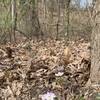Dogs Leashed

Features
Birding · Fall Colors · River/Creek · Views · Waterfall

Overview

The Burkhardt trail is a 3.3 mile lariat route with a beautiful stop at
Willow Falls halfway through.
Need to Know

Located in Willow River State Park, this trail is only a 40-minute drive from the Twin Cities. Unless you have a Wisconsin state park pass, you’ll have to stop by the park office to get one ($11/day or $38/annual for out-of-state plates; $8/day or $28/annual for WI plates). The parking area for the Burkhardt trailhead is not accessible from the main park entrance; it is located on the south side of River Road a short drive from the main entrance.
Description

The intersections for this trail are all well marked with maps so you would need to try pretty hard to get lost. Starting at the River Road parking area, the Burkhardt trail winds through deciduous forests and prairie. As you make your way along this path, there are numerous opportunities to spot birds and butterflies, and even the occasional rabbit or deer.
The start of this trail follows the Willow River and is fairly level. The trail begins to climb uphill about 0.4 miles in. The climb is steep in places, through the trail is not particularly technical. At your first intersection about 0.6 miles in, take a right; the trail climbs a little more and at 0.8 miles, at the second intersection take another right to find yourself at the top of a nice long downhill that takes you into the river valley.
At about 1.5 miles you'll reach the bottom of the valley and find yourself at the river. To your left is a set of stairs that you'll take to continue your journey, but for now, take a break! In front of you is a bridge that crosses the river and connects up to other trails in the rest of the park. Here you'll find the highlight of the park,
Willow Falls. A perfect spot for a rest, snack, and maybe even a dip. If you choose to leave the path and sit by the falls (like many do), be very careful. The river cuts into limestone which, even when dry can be quite slippery underfoot. With a little water on it however, it can feel like ice to the unsuspecting foot!
Tucked into the river valley with tall limestone walls and abundant shade,
Willow Falls are the perfect place to hangout and enjoy a picnic or a sunny summer afternoon. If you’re lucky you might even get to see some people rock climbing up the overhanging limestone walls, though if this is your goal, keep in mind the area is closed to climbing on Saturdays.
Once ready to continue on your way, head back to the staircase that ascends almost 200 feet in less than 0.1 miles. This staircase takes you up to an overlook of the falls and what was once Little Falls Lake. The lake was drained in 2015 after concern over safety of the lower dam. Once the dam is replaced, the lake will refill, however, this is expected to take several years.
At the intersection after the overlook, take a right to continue on the outside loop of Burkhardt Trail. There is a little more uphill (though more gradual) up some steps built into the trail. Continue this way to a second overlook. Being a little farther away from the falls, this overlook is much quieter and nice spot to sit if you’re looking for some solitude; however, there is not much in the way of views, though in the autumn the fall colors would make it very picturesque.
The trail continues on with a few rolling ups and downs. Go right at the next two intersections, which will lead you back to the trail you came in on. Take one last right to head back out to the parking area.
Trail Notes:
The trail itself is not particularly technical; it is a path wide enough for a park service vehicle and in most places is grass or loose sand and gravel. There are a few steeper ups and downs on this loop trail, and one long set of stairs that ascend quite steeply.
Flora & Fauna

Birds, butterflies, deer, and rabbits
History & Background

In the 1830s the Willow River was used for transporting logs to the St. Croix River. German immigrant, Christian Burkhardt (namesake of the Burkhardt trail), began to develop hydroelectric power plants along the Willow River in 1891, which operated until 1963. In 1967 the land was sold to the Wisconsin Conservation Commission to be developed as a state park, which opened in1971.
Contacts
Shared By:
Liz

 Red Trail
Red Trail




 Lake Elmo, MN
Lake Elmo, MN
 Afton Tour North
Afton Tour North




 Afton, MN
Afton, MN
 William O'Brien Tour
William O'Brien Tour




 Scandia, MN
Scandia, MN
 Bailey School Forest Trail
Bailey School Forest Trail




 Newport, MN
Newport, MN
 Holland Lake Lollipop
Holland Lake Lollipop




 Eagan, MN
Eagan, MN
 Lebanon Hills Regional Park
Lebanon Hills Regional Park




 Eagan, MN
Eagan, MN





0 Comments